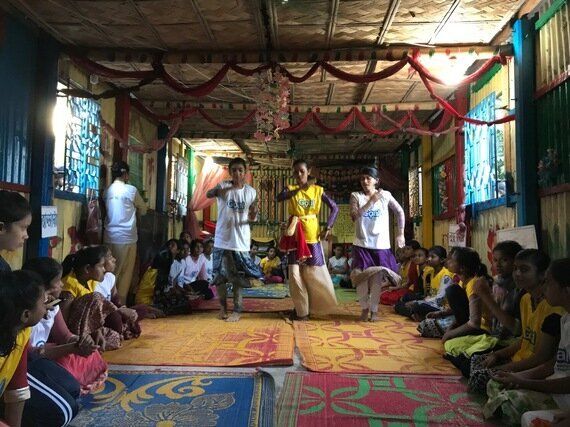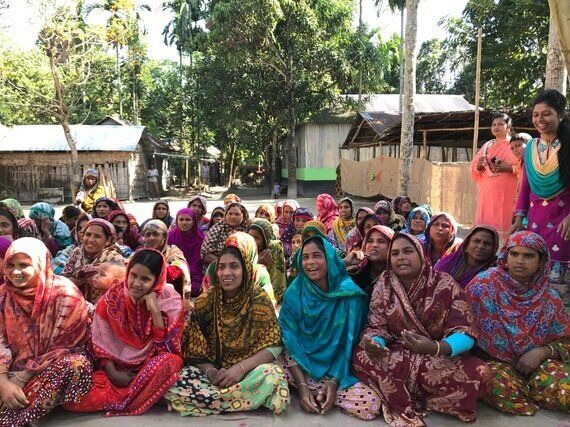The World Economic Forum recently published its Global Gender Gap Report 2017 and the data is not encouraging. Over the course of the last year, progress made on gender equity has actually been reversed. Take for example the gaps between economic and political participation of men and women; they remain shockingly high. Only 58% of the economic participation gap has been closed; 2017 is the second consecutive year of reverse progress in this area and represents the lowest value measured by the index since 2008. Despite all the global talk of girls' and women's economic empowerment, things are getting worse, not better.
I was recently in Bangladesh to understand what challenges continue to dampen the economic future of girls and women. While the women and girls in the country have made strides in closing the gap (Bangladesh ranks 47 out of 144 on women's economic participation and opportunity), the situation is still quite striking, and clearly, there is much more to do.
Having spoken to girls and women across the country, in urban and rural settings, in government schools and extracurricular clubs run by non-profits, in the traffic plagued streets of Dhaka and under the shade of trees in remote villages, I gleaned three issues we must all consider when building effective and impactful programs to further the economic empowerment of the girls and women of Bangladesh.
1.Prioritising Safety
In the suburbs of Dhaka, I met over 40 adolescent girls enrolled in Standard Chartered's Goal program run by local partner BRAC. I witnessed them navigate the challenges of peer pressure, dance routines they choreographed and sing songs extolling the importance of agency and self-determination. What was most striking, however, was their passion for karate.

Goal girls demonstrate their karate and self defense skills
The girls told me about their reluctance to go out alone for fear of being attacked or assaulted; they shared that learning karate not only increased their confidence but enabled them to move about the streets more safely. During the session I attended, boys and men peaked into the Deilla clubroom and tried to see what the girls were learning. The word in the community about the karate must have gotten out, because the girls admitted that they were experiencing less bullying and harassment by the local boys since the inception of the program.
The most jarring scene I witnessed during my visit was the girls practicing their defenses against rape. "To rape position," the instructor called, and half of each pair laid prostrate on the floor. The other half proceeded to mimic a sexual assault and was repelled by a series of moves, strategies and tactics.
To see these girls practice their defenses against rapists really reinforced how bad the situation is. Equipping these girls with self defense and karate is certainly an important, critical step, but we must also engage local communities including men and boys about the importance of respecting the physical rights of girls and women. These girls will not experience true safety and freely participate in economic opportunity until we are able to lower the incidence and tolerance of sexual violence.
2. Going Digital
Technology, laptops, digital literacy, computers, mobiles, internet. These words were uttered to me in every single one of my project visits in Bangladesh. One of the participants in the joint Standard Chartered/BRAC Kurigram Integrated Livelihood and Financial Literacy program summed it up best when she said to me "if I am not able to use a computer, I might as well be illiterate."

Participants in Kurigram program
In recent years, the global community has been obsessed by the "skills gap"- the disconnect between what young people are (and are not) learning in school and what employers and the economy will require of them in the future. As automation increases across the world, many traditional jobs will be eliminated, and pundits predict that unemployment will sky rocket. The most vulnerable are those who lack access to quality education...and technology.
As we think about interventions that further enable girls and women to embrace economic opportunity, we need to consider how we integrate STEM into programming. Digital fluency has become a critical life skill, and girls and women are disproportionately denied access to technology. If we want to give girls and women a fair chance, we have to help them navigate this new digitized world.
3. Leaning into the multiplier effect
We know the adage well: invest in a woman and you invest in her whole family. Research consistently proves that the return on investment in girls' and women's programs is higher, because health and education outcomes in families and children also improve. As Bob Zoellick, former President of the World Bank, famously quipped "gender equality is smart economics."
While I know what all the data and research says, what I didn't appreciate until my visit to Bangladesh was the intense desire of girls and women to pass on the knowledge to their friends and family. They are an untapped resource, and we must leverage them.
Visiting Standard Chartered's Financial Education for Youth program at the Biddut Unnayan Board High School in Monsurabad, I anticipated the girls' enthusiasm to learn about financial management and change their savings behavior. What I didn't expect, however, was the number of girls who had passed on the knowledge to their friends and family. Take fifteen year old Moni for example. She participated in the program in 2016; now, without any prompting from her school or the Bank, she conducts financial education sessions for her peers every week at her school. She feels an intense desire to empower and equip others with the knowledge she's gained. And she's doing it entirely on her own with no resource or toolkit.

The multiplier effect embodied in Moni
Imagine the impact if we supported girls and women like Moni who are determined to pay their knowledge forward. What if we provided resources, formal training and teaching techniques to her so that she could maximize her effectiveness and reach?
The multiplier effect isn't just an economic theory; it's a reality that we must embrace and build into all our programs - not only to deepen impact but to realize sustainability. We must embed models of peer leadership and mentoring in all youth and gender programs, so that multipliers like Moni can lead by example, help empower more girls and women and unleash economic potential of women and girls everywhere.
As my trip to Bangladesh concludes, I feel pride in the immense positive impact that Standard Chartered is having on the girls and women in the community, but I also feel dissatisfaction, because there is so much more we could do.
Project visits like these help to clarify how we can deepen our impact and improve the community programs we care about. As the global talk on girls' and women's economic empowerment continues into 2018, I hope we can better integrate considerations of safety, technology and peer leading into interventions. Programmatic adaptations like these will enable us to narrow the gap between men and women's economic participation and correct the course of the widening gender gap around the world. A winning prospect for all.